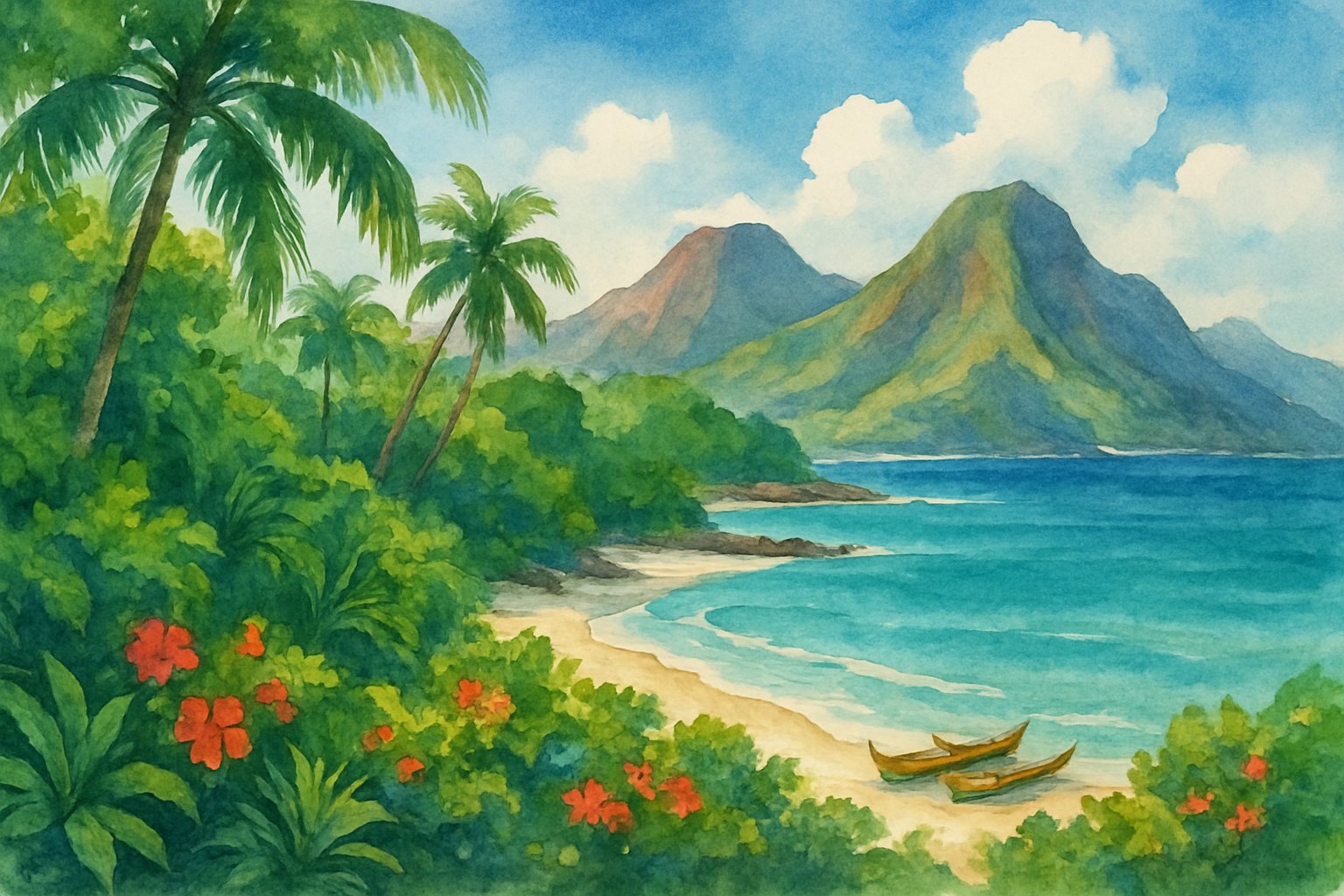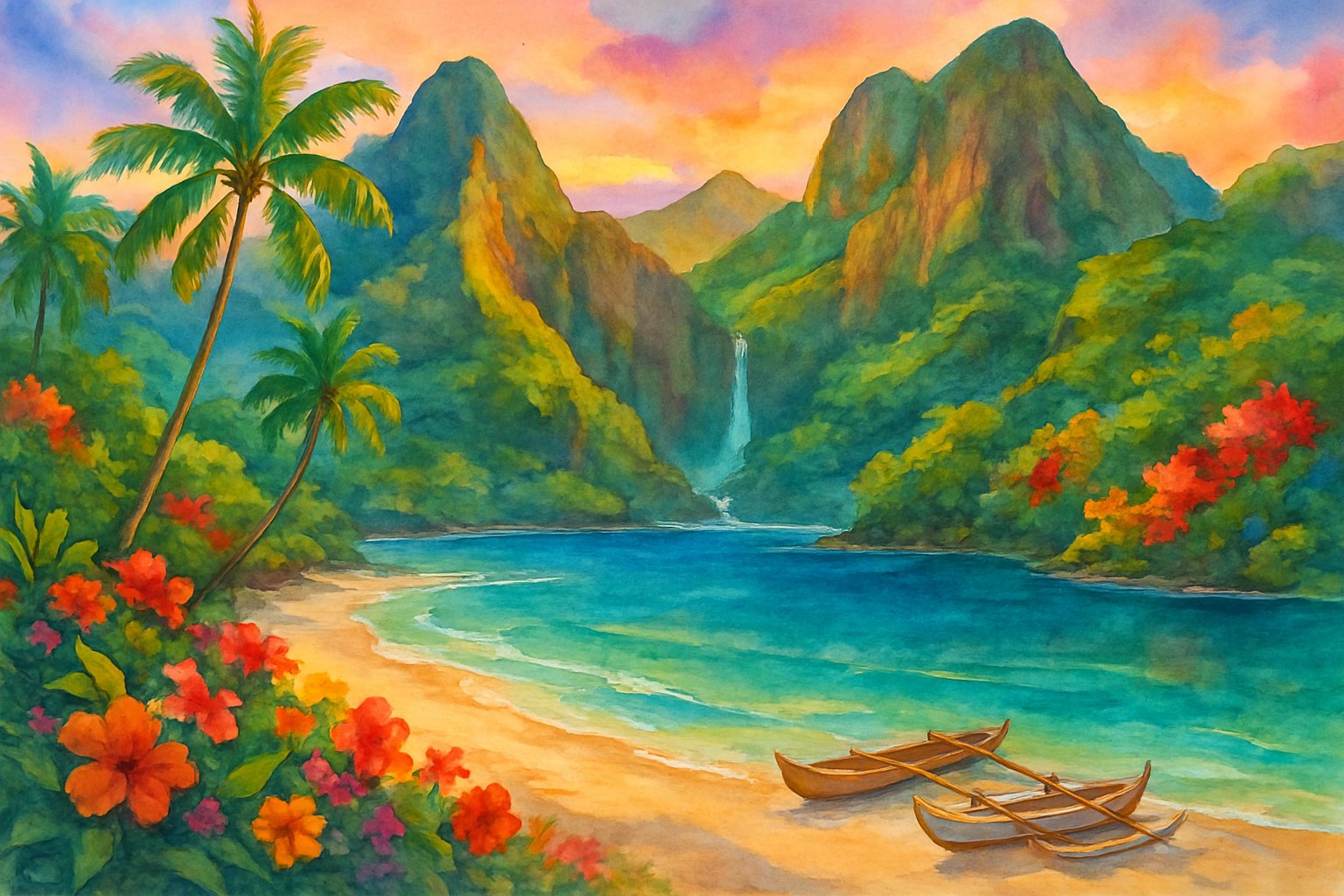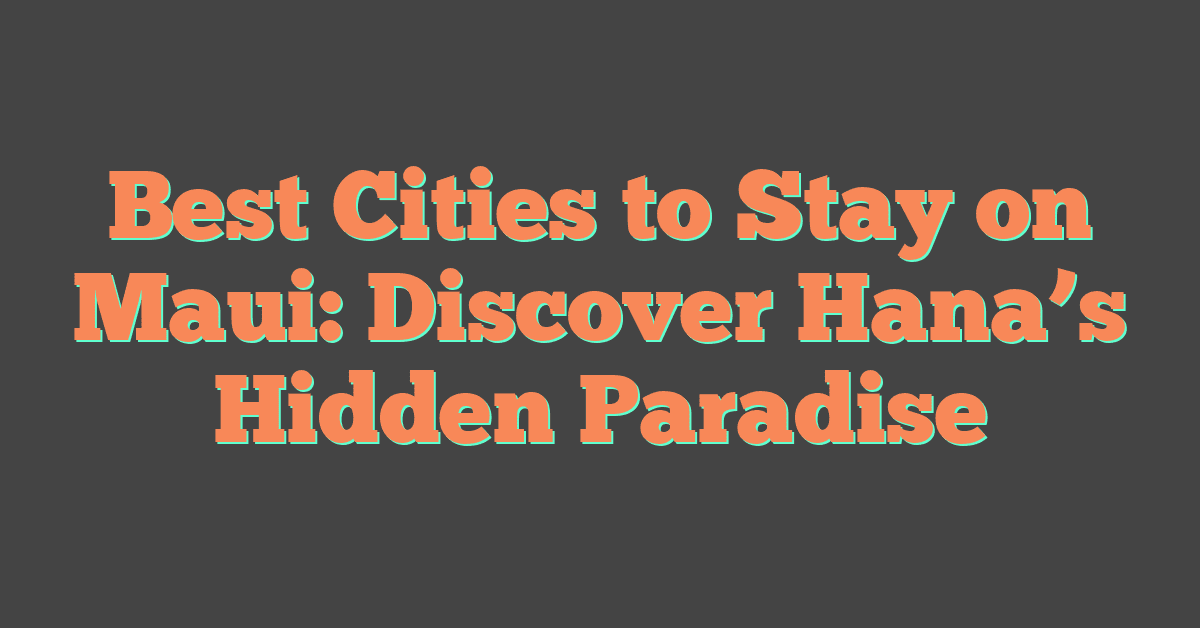When I think of Hawaii, I picture tropical beaches and famous places like Oahu or Maui.

But did you know the Hawaiian chain has about 137 volcanic islands, many of which almost no one talks about?
Some of Hawaii’s most interesting islands are hidden gems that most travelers have never even heard of, each with their own unique story and charm.

I love searching for the lesser-known corners of the world.
That’s why I explore the secret side of island life, where untouched nature and local culture still thrive.
From the mysteries of Niihau, sometimes called the “Forbidden Island,” to peaceful spots like Molokai and secluded areas in Oahu, these islands show a completely different side of Hawaii.
If you’re curious about the real Hawaii, away from crowds, these hidden Hawaiian islands will surprise you.
Some are hard to reach, and others are off-limits to the public, but all have fascinating histories.
What Makes Hawaii’s Hidden Islands Unique?
Hawaii’s hidden islands feel far removed from busy tourist spots.
Each one has its own story, special ecosystem, and peaceful settings that show a different side of Hawaii.
Seclusion and Natural Beauty
When I visit these hidden Hawaiian islands, I notice how quiet and untouched they feel.
There are hardly any crowds, and sometimes I walk alone on the beaches.
The ocean views go on forever, with no big hotels or busy roads.
These islands make it easy to relax because life moves slowly.
It’s not unusual to hear only the wind and waves.
Some places, like Niihau, are even called “forbidden” since visitors need special permission to go.
This keeps the island feeling wild and private.
The natural beauty is amazing—colorful sunsets, rocky cliffs, clear tide pools, and long stretches of untouched coastline.
When I want a break from noise and crowds, I love watching the sun dip behind the ocean on one of these hidden shores.
Distinct Ecosystems
Each hidden island has a unique mix of plants and animals because they are isolated.
Some islands are home to rare native birds and plants that don’t exist anywhere else.
For example, Hawaiian seabirds nest undisturbed on rocky ledges by the water.
Many of these islands remain untouched by development.
Native plants, such as the rare Hawaiian silversword, thrive in places where outsiders rarely go.
Because these islands are isolated, non-native species have a harder time taking over, helping the natural balance last.
Some islands have very different environments, from dry grasslands to hidden wetlands and dense forests.
Exploring these places, I get to see native ecosystems up close—places where nature is the main attraction and people are just visitors.
Cultural and Historical Significance
These islands hold a strong sense of Hawaiian culture.
Some hidden islands have stayed in the same families for generations, which helps keep old traditions alive.
On Niihau, people still speak Hawaiian every day.
Historic sites—like ancient fishponds and old stone walls—dot the landscape.
I’ve seen petroglyphs and sacred sites that show how connected early Hawaiians were to these places.
Residents still practice traditional crafts and skills, passing their knowledge from one person to the next.
Visiting these islands gives a window into the past.
The deep respect for nature is clear, and every experience feels tied to Hawaiian history and stories.
Molokai: The Unexpected Adventure
When I think of Molokai, I picture a quiet Hawaiian island where nature comes first.
Wild beaches, high sea cliffs, peaceful trails, and deep cultural roots wait to be explored.
Untouched Beaches and Outdoor Activities
One of my favorite things about Molokai is how empty the beaches feel.
Many are not crowded, so I can relax, swim, or walk for long stretches without seeing anyone.
The white sands of Papohaku Beach stretch for nearly three miles.
Sometimes, I spot local fishermen bringing in fresh catch in the early mornings.
I spend my days kayaking along the shore, snorkeling in the clear water, or fishing from the rocky points.
Camping is another option at some beaches, letting me fall asleep to the sound of waves under the stars.
There’s beach access for picnics, making this island friendly for families looking for a quiet retreat.
For more trip details, check out Molokai visitor info.
Majestic Waterfalls and Hiking Trails
Molokai has some of the tallest sea cliffs in the world.
The hiking trails often offer amazing views.
I like the Halawa Valley hike because it goes through a rainforest and ends at a waterfall over 250 feet high.
Local guides share Hawaii’s old traditions and stories along the way, making the hike about both sights and culture.
The Kamakou Preserve stands out for its rare plants and native birds.
A boardwalk trail cuts through rainforest and muddy ground.
When the clouds lift, I see stunning views of the valleys below.
There are also more challenging hikes for experienced hikers looking for adventure.
For more inspiration, see how adventurers enjoy Molokai’s trails and waterfalls.
Exploring Historic Sites
Exploring Molokai’s history helps me feel more connected to Hawaii’s past.
Kalaupapa National Historical Park is probably the island’s most famous site.
It once served as a leper colony but now welcomes respectful visitors.
I learned a lot about the people who lived there and the missionaries like Father Damien who cared for them.
Small towns like Kaunakakai have stores and bakeries that have been around for decades.
In the east, I visit churches built in the 1800s and see simple homes kept by local families for generations.
Every visit feels like a step back in time, with tradition and hospitality still alive.
If you want to dig deeper into Molokai’s past, you can start by looking at travelers who went in search of authentic Hawaii.
Lana’i: The Mystical Pineapple Island
Lana’i feels far from Hawaii’s busy tourist spots.
The island’s landscapes, quiet beaches, and unique activities make it special for anyone looking to relax or explore.
Garden of the Gods: Otherworldly Landscapes
My first stop on Lana’i is always the Garden of the Gods.
This area, also called Keahiakawelo, has huge boulders and strange rock formations in red and orange earth.
It looks like another planet.
When I walk through here, I see the sunlight change colors on the rocks.
The land feels almost silent except for the wind.
It’s not crowded, and sometimes it’s just me and rows of Cook Island pine trees in the distance.
Exploring this area is great for photos and quiet thoughts.
The road is rough, so I always use a four-wheel drive vehicle for the trip.
Uncrowded Beaches and Relaxation
If I want to relax, the beaches around Lana’i are perfect.
There are long stretches of sand with almost no people.
Shipwreck Beach stands out with its rusty shipwreck views and crashing waves.
I bring a book or just watch the ocean.
Sometimes, I spot green sea turtles in the water.
Many hotels and villas have hot tubs or pools.
After a day hiking or exploring, it feels good to soak and look at the stars.
The slow pace on Lana’i makes it easy to forget about crowds or busy schedules.
I can unwind and breathe in the fresh air from upland pine trees.
Adventure Activities and Island Experiences
Lana’i may feel calm, but there is plenty to do if I want adventure.
The island has hiking trails through pine forests and rocky hills.
ATVs and four-by-fours help me reach remote places.
For something different, I join snorkeling trips or try scuba diving off the coast.
I also explore the island’s history.
Old pineapple plantations remind me why Lana’i is still called the Pineapple Isle.
Guided tours show hidden views and tell stories about the people who shaped the island.
Local cafes serve fresh fish and treats.
Every day feels new, whether I’m walking on lava stones or learning about old legends from Lana’i’s past.
The Forbidden Island of Niʻihau
Niʻihau stands out because it’s mostly closed off to the public and has a small, close-knit community.
It’s sometimes called “The Forbidden Isle” due to its strict visitor rules and well-protected natural beauty.
Unique Access and Visitor Requirements
The Robinson family owns Niʻihau.
Unlike other Hawaiian islands, most people cannot land on its beaches.
Only the Robinsons, their relatives, and select guests can visit.
Some U.S. Navy staff and government officials may enter for official duties.
Regular tourism isn’t allowed on Niʻihau.
Tour companies sometimes offer boat tours, snorkeling, and helicopter trips that let people see the shoreline or swim just offshore, but you can’t actually walk on the island.
The residents of Niʻihau speak Hawaiian as their main language.
They live a traditional lifestyle, with little modern infrastructure.
There are no paved roads, and electricity comes from solar power.
People on Niʻihau do not use money in the same way as on other islands.
For more details and a look at how Niʻihau is known as Hawaii’s Forbidden Island, check out its background.
Wildlife and Natural Attractions
Niʻihau is a special place for nature lovers like me. Many rare plants and animals live here that you won’t easily find on other Hawaiian islands.
Birdwatchers can spot endangered species such as the Hawaiian coot. Monk seals often rest on the beaches.
Few people visit, so the landscapes and beaches remain clean. The island features white sand beaches, clear waters, and volcanic rock formations.
Sea life fills the reefs, making snorkeling nearby exciting. Dolphins and colorful fish swim in the waters off Niʻihau’s coast.
The ocean around the island offers excellent diving spots. For more about Niʻihau’s natural side, see this overview of attractions and diving.
Kaho‘olawe: History and Restoration
Kaho‘olawe is a small Hawaiian island with a rich history. People once used it for navigation, and now it’s the focus of important environmental and cultural projects.
Special places on the island connect to Hawaiian history and nature.
Sacred Sites and Cultural Tours
Kaho‘olawe is full of sacred sites that Native Hawaiians used long before outsiders arrived. Early Hawaiians settled along the coast, leaving behind old fishing villages and stones for navigation.
The island served as a center for celestial navigation in Hawaii. Stone markers helped sailors find their way across the ocean.
Because Kaho‘olawe is so important, only people involved in cultural or restoration work can usually visit. These trips focus on learning about the island’s past and respecting sacred spaces.
Strict rules guide every visit to protect historic sites, especially places linked to ancient rituals and navigation. Learn more at the Kaho‘olawe Island Reserve Commission’s history page and the WW2 Museum site.
Conservation Efforts
Restoring nature on Kaho‘olawe takes a lot of effort. In the past, the U.S. Navy used the island for target practice, which damaged the land and left behind unexploded bombs.
Now, the Kaho‘olawe Island Reserve manages the island to save native plants and rebuild the habitat. Volunteers plant trees and protect the coast from erosion.
Large areas still remain unsafe, but each year more of the island turns green again. Restoration means carefully balancing respect for sacred sites with healing the land.
Find more about ongoing restoration at the Kaho‘olawe Island Reserve Commission and this feature on rewilding efforts.
Secret Spots on Popular Islands
Some of Hawaii’s best places hide away from the crowds. Beautiful beaches, hidden caves, and peaceful hikes offer a different experience from the usual tourist spots.
Hidden Corners of Kauai
When I first visited Kauai, I skipped the main tourist stops and searched for quiet escapes. Waimea Canyon, called the “Grand Canyon of the Pacific,” has rim trails with few visitors.
I hiked to remote lookouts and rarely saw anyone else. There’s a secret cave on Kauai with a glowing pool.
When sunlight hits the calcite rocks, the water shines a bright blue. The peaceful atmosphere makes the effort to find it worthwhile.
On the north shore, Hanalei Bay is famous, but I walk past the main beach to find quiet stretches of sand. The further I go, the easier it is to relax and enjoy the mountain views.
Napali Coast has less crowded trails if you start early in the morning.
Oahu’s Lesser-Known Shores
Waikiki draws most visitors, but I prefer the secluded beaches elsewhere on Oahu. On the North Shore, crowds gather at big surf spots, but I explore quiet tide pools and hidden coves behind lava rocks.
Secret gardens inland feature native plants and streams where almost no one goes. Hikes away from Waikiki lead to lookout points with great city views, minus the crowds.
For a laid-back day, I visit beach parks popular with locals. Sometimes, I drive the coastal roads to find new picnic spots.
Some public places are hardly visited, especially on weekdays. A little exploring always leads to a peaceful corner.
Maui’s Off-the-Path Retreats
Maui is famous for Haleakala National Park and the Road to Hana, but quiet spots are easy to find nearby. I visit lesser-known trails in Haleakala, where the only sound is the wind.
The small town of Makawao in upcountry Maui feels far from busy beaches. I enjoy its local art galleries and cowboy history.
It’s a nice spot for a picnic after hiking in the forests above town. Heading toward Hana, I stop at peaceful gardens and small waterfalls off the main road.
Often, I have these places to myself. Coastal paths near Hana lead to rocky coves and tide pools, perfect for relaxing and spotting sea turtles.
Adventure and Outdoor Activities
Hawaii’s hidden islands offer many ways to enjoy nature up close. Whether swimming in clear ocean waters or hiking rainforest trails, each activity lets you see Hawaii’s wild side.
Snorkeling and Scuba Diving
When I visit these islands, snorkeling is one of my favorite activities. The water stays clear, and the coral reefs are healthy.
I often see colorful fish, sea turtles, and even manta rays while snorkeling or scuba diving. Some lesser-known spots have calm, shallow areas perfect for beginners.
For more adventurous dives, hidden coves and lava tubes wait to be explored. Many of these places are uncrowded, so I feel like I have the reefs to myself.
Before I go in, I wear reef-safe sunscreen and check for strong currents. Guided tours are available, and local guides know the best secret locations.
For more details, check out this list of outdoor activities in Hawaii.
Scenic Hikes and Waterfalls
Hiking on these islands takes me through rainforests, over old lava flows, and into secret valleys. Some trails are short and easy, while others need more effort.
Often, the reward is a beautiful view or a hidden waterfall. I always bring extra water and good shoes because some paths are muddy.
My favorite hikes lead to waterfalls that tumble into clear pools, perfect for a quick swim. Wildlife is everywhere, and I sometimes spot wild birds or rare flowers along the trail.
Signs may point out interesting plants or history. There are many hiking trails and waterfall hikes across the islands.
Cliff Jumping and Surfing
For a thrill, I try cliff jumping at safe spots locals recommend. The cliffs are usually not too high, making the jumps fun but manageable.
Before I jump, I always check the water depth and look for rocks. Safety matters, and local advice helps me choose good spots.
Surfing is also popular on these islands. Hidden beaches sometimes have gentle waves for beginners and breaks for advanced surfers.
I rent a board or join a lesson if I’m new to a beach. Conditions can change quickly, so I check the weather and surf reports before heading out.
To learn more about unique outdoor experiences, read about them here.
Relaxation and Wellness Escapes
Hawaii’s quieter islands provide a calm escape for anyone who wants to recharge. Many resorts and hidden spots focus on wellness, letting me slow down and care for my mind and body.
Yoga Retreats and Spa Experiences
On Lana’i, wellness is everywhere. Places like Sensei Lana’i, a wellness resort, offer yoga classes in peaceful, open-air settings.
Teachers guide stretching, breathing, and gentle movements. I relax as I listen to birds and soft breezes during each session.
Many resorts on hidden islands offer full spa experiences. I can choose massages, facials, and body wraps.
Some spas use Hawaiian traditions and local flower oils. Time in these spas helps me feel refreshed.
A few places have meditation gardens where I can sit quietly and clear my mind.
Hot Tubs and Seaside Relaxation
After yoga or exploring, I enjoy relaxing in a hot tub while watching the sun set. Many small island resorts have private hot tubs in rooms or outdoors.
Sitting in the warm water as night falls is one of my favorite ways to unwind. On Lanai, the cool evening air makes the hot tub even more soothing.
At some resorts, I find cozy spots by the sea with lounge chairs at the water’s edge. I listen to gentle waves and watch the sky change colors while I rest.
The simple experience of quiet, warm water and fresh air makes me feel calm and happy.
Planning Your Visit to Hawaii’s Hidden Islands

Planning a trip to Hawaii’s lesser-known islands takes more research than visiting bigger spots like Oahu.
Flights, lodging, and the best ways to get around can be different when you head off the beaten path. The right tips make your adventure easier and more enjoyable.
Getting There and Transportation Tips
You usually reach Hawaii’s small, hidden islands by taking a smaller plane, ferry, or sometimes a private boat. For example, you can take a short ferry ride from Maui to Lanai, while regular flights connect Honolulu and Maui to Molokai.
Flight and ferry schedules may be limited, so I always check them well in advance.
On the islands, public transportation is often limited or not available. I usually rent a car because most beaches and popular sights have parking, but I make sure to check parking rules to avoid tickets.
Some resorts offer shuttle services, but these are often limited outside big towns.
If you love exploring beaches, you can drive right up to some spots like Shipwreck Beach on Lanai. I read recent reviews on sites like Tripadvisor to see if beaches or trails are open and to check road conditions.
Where to Stay
Lodging options on Hawaii’s hidden islands are usually fewer and simpler than on the larger islands, but I find that’s part of the charm. Lanai offers a few high-end resorts, smaller hotels, and vacation rentals.
Molokai’s main options include condo rentals, small inns, or guesthouses. I prefer to book early, especially during peak travel seasons, because rooms fill up fast.
Some places offer extras like free parking and breakfast, which helps with my budget. You can also camp on some islands for a more rugged experience, but you need to get permits before you arrive.
I check recent guest reviews on Tripadvisor to avoid surprise closures or construction.
Essential Travel Tips
On hidden islands, I find fewer stores and restaurants, so I plan my meals and activities ahead of time.
I pack snacks and bring refillable water bottles, especially for long hikes or days at the beach.
Cell service often drops in remote areas. I download maps and important information before I leave.
Beach access rules can differ from those on big islands. Some sites allow public access only during certain seasons or hours.
I check local guides or ask hotel staff about current rules.
I book activities like guided tours or water sports in advance because fewer vendors offer these services, and spots fill up quickly.
I respect local customs and always follow posted rules, especially at protected areas or sacred sites.




